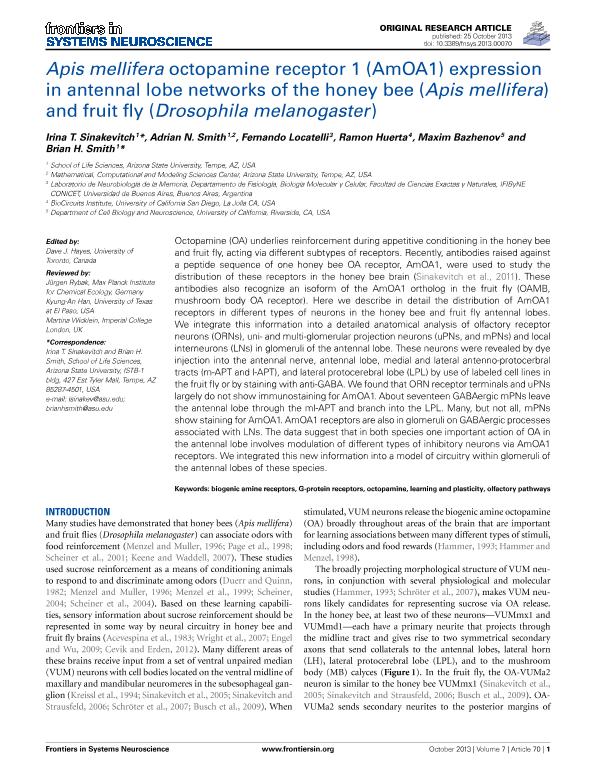Mostrar el registro sencillo del ítem
dc.contributor.author
Sinakevitch, Irina T.
dc.contributor.author
Smith, Adrian N.
dc.contributor.author
Locatelli, Fernando Federico

dc.contributor.author
Huerta, Ramón
dc.contributor.author
Bazhenov, Maxim
dc.contributor.author
Smith, Brian H.
dc.date.available
2017-07-21T18:18:03Z
dc.date.issued
2013-10
dc.identifier.citation
Sinakevitch, Irina T.; Smith, Adrian N.; Locatelli, Fernando Federico; Huerta, Ramón; Bazhenov, Maxim; et al.; Apis mellifera octopamine receptor 1 (AmOA1) expression in antennal lobe networks of the honey bee (Apis mellifera) and fruit fly (Drosophila melanogaster); Frontiers; Frontiers in Systems Neurosciences; 7; 10-2013; 1-19; 70
dc.identifier.issn
1662-5137
dc.identifier.uri
http://hdl.handle.net/11336/21099
dc.description.abstract
Octopamine (OA) underlies reinforcement during appetitive conditioning in the honey bee and fruit fly, acting via different subtypes of receptors. Recently, antibodies raised against a peptide sequence of one honey bee OA receptor, AmOA1, were used to study the distribution of these receptors in the honey bee brain (Sinakevitch et al., 2011). These antibodies also recognize an isoform of the AmOA1 ortholog in the fruit fly (OAMB, mushroom body OA receptor). Here we describe in detail the distribution of AmOA1 receptors in different types of neurons in the honey bee and fruit fly antennal lobes. We integrate this information into a detailed anatomical analysis of olfactory receptor neurons (ORNs), uni- and multi-glomerular projection neurons (uPNs, and mPNs) and local interneurons (LNs) in glomeruli of the antennal lobe. These neurons were revealed by dye injection into the antennal nerve, antennal lobe, medial and lateral antenno-protocerbral tracts (m-APT and l-APT), and lateral protocerebral lobe (LPL) by use of labeled cell lines in the fruit fly or by staining with anti-GABA. We found that ORN receptor terminals and uPNs largely do not show immunostaining for AmOA1. About seventeen GABAergic mPNs leave the antennal lobe through the ml-APT and branch into the LPL. Many, but not all, mPNs show staining for AmOA1. AmOA1 receptors are also in glomeruli on GABAergic processes associated with LNs. The data suggest that in both species one important action of OA in the antennal lobe involves modulation of different types of inhibitory neurons via AmOA1 receptors. We integrated this new information into a model of circuitry within glomeruli of the antennal lobes of these species.
dc.format
application/pdf
dc.language.iso
eng
dc.publisher
Frontiers

dc.rights
info:eu-repo/semantics/openAccess
dc.rights.uri
https://creativecommons.org/licenses/by-nc-sa/2.5/ar/
dc.subject
Abejas
dc.subject
Octopmania
dc.subject
Olfato
dc.subject
Glomerulos
dc.subject.classification
Otras Ciencias Biológicas

dc.subject.classification
Ciencias Biológicas

dc.subject.classification
CIENCIAS NATURALES Y EXACTAS

dc.title
Apis mellifera octopamine receptor 1 (AmOA1) expression in antennal lobe networks of the honey bee (Apis mellifera) and fruit fly (Drosophila melanogaster)
dc.type
info:eu-repo/semantics/article
dc.type
info:ar-repo/semantics/artículo
dc.type
info:eu-repo/semantics/publishedVersion
dc.date.updated
2017-07-11T13:21:23Z
dc.journal.volume
7
dc.journal.pagination
1-19; 70
dc.journal.pais
Suiza

dc.description.fil
Fil: Sinakevitch, Irina T.. Arizona State University; Estados Unidos
dc.description.fil
Fil: Smith, Adrian N.. Arizona State University; Estados Unidos
dc.description.fil
Fil: Locatelli, Fernando Federico. Consejo Nacional de Investigaciones Científicas y Técnicas. Oficina de Coordinación Administrativa Ciudad Universitaria. Instituto de Fisiología, Biología Molecular y Neurociencias. Universidad de Buenos Aires. Facultad de Ciencias Exactas y Naturales. Instituto de Fisiología, Biología Molecular y Neurociencias; Argentina
dc.description.fil
Fil: Huerta, Ramón. University of California at San Diego; Estados Unidos
dc.description.fil
Fil: Bazhenov, Maxim. University of California; Estados Unidos
dc.description.fil
Fil: Smith, Brian H.. Arizona State University; Estados Unidos
dc.journal.title
Frontiers in Systems Neurosciences
dc.relation.alternativeid
info:eu-repo/semantics/altIdentifier/doi/http://dx.doi.org/10.3389/fnsys.2013.00070
dc.relation.alternativeid
info:eu-repo/semantics/altIdentifier/url/http://journal.frontiersin.org/article/10.3389/fnsys.2013.00070/full
Archivos asociados
